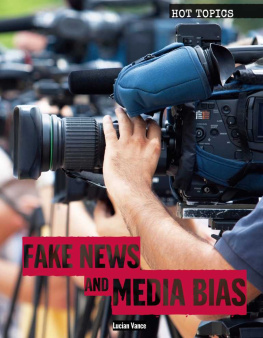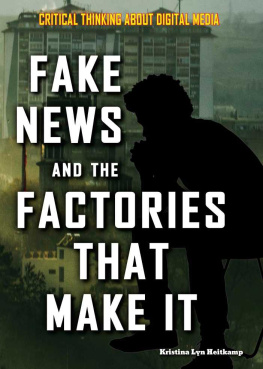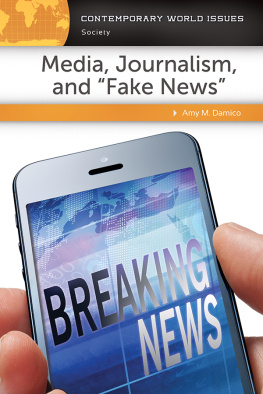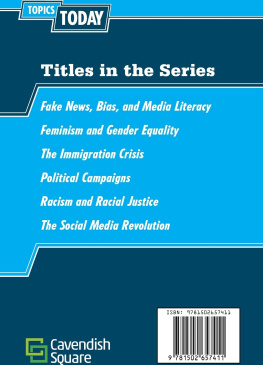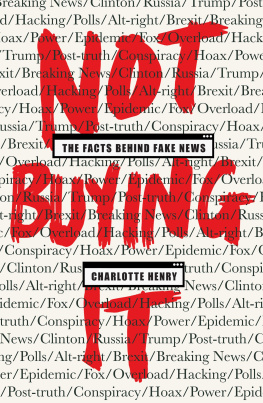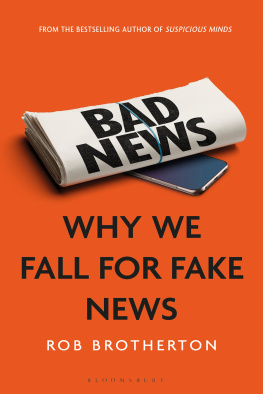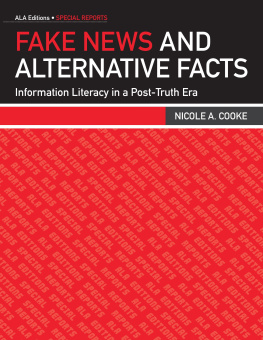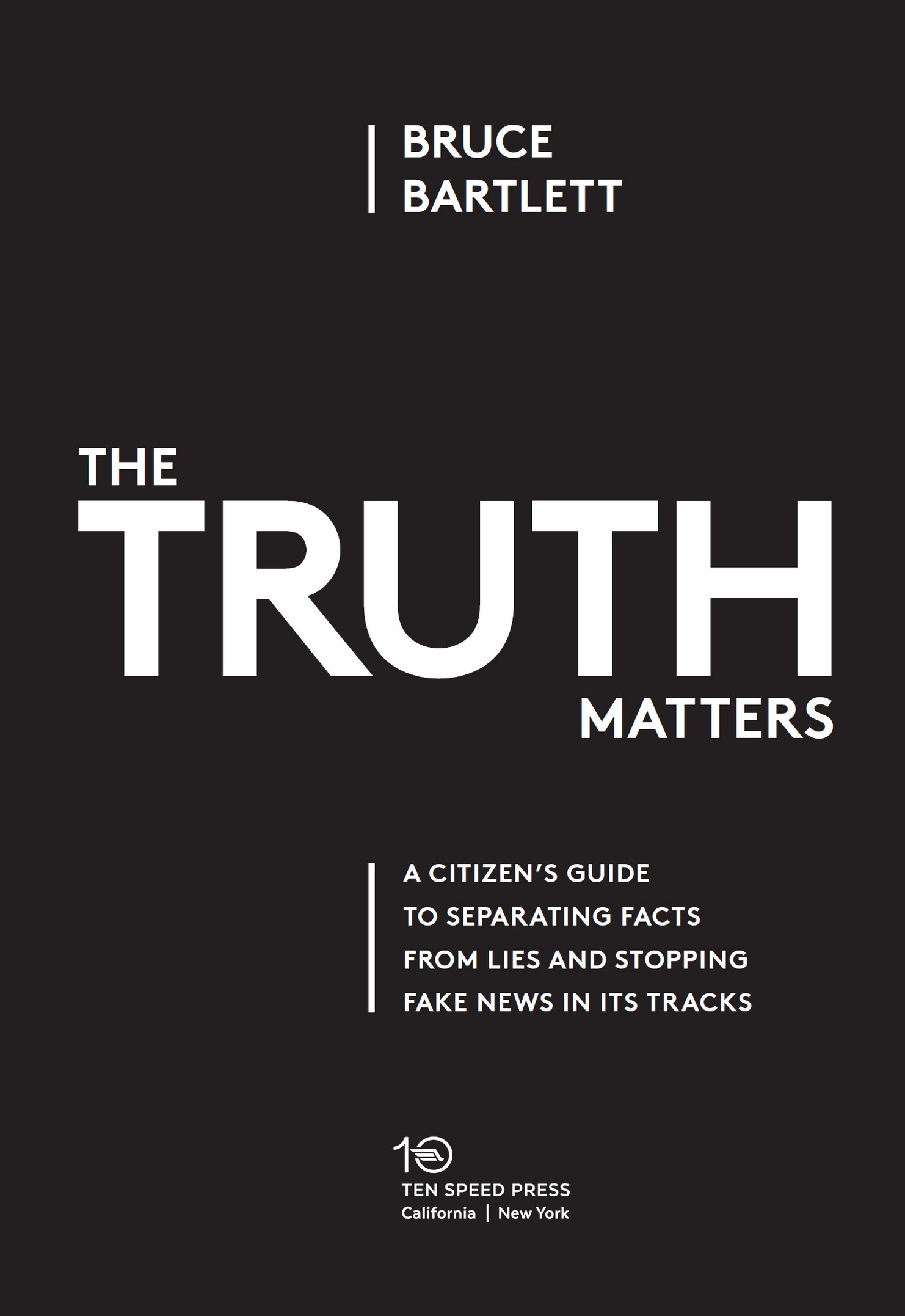Contents
Copyright 2017 by Bruce Bartlett
All rights reserved.
Published in the United States by Ten Speed Press, an imprint of the Crown Publishing Group, a division of Penguin Random House LLC, New York.
www.crownpublishing.com
www.tenspeed.com
Ten Speed Press and the Ten Speed Press colophon are registered trademarks of Penguin Random House LLC.
Library of Congress Cataloging-in-Publication Data
Names: Bartlett, Bruce R., 1951- author.
Title: The truth matters : a citizens guide to separating facts from lies and stopping fake news in its tracks / Bruce Bartlett.
Description: First edition. | California, N.Y. : Ten Speed Press, 2017. | Includes bibliographical references.
Identifiers: LCCN 2017028338 (print) | LCCN 2017029755 (ebook) |
Subjects: LCSH: JournalismHistory21st century. | Attribution of news. | News audiences.
Classification: LCC PN4815.2 (ebook) | LCC PN4815.2 .B37 2017 (print) | DDC 070.90/51dc23
LC record available at https://lccn.loc.gov/2017028338
Hardcover ISBN9780399581168
Ebook ISBN9780399581175
v4.1
a
To all the journalists who gave their lives to bring us the news.
CONTENTS
INTRODUCTION
Once upon a time, Americans could read their local newspaper, subscribe to a weekly newsmagazine, and watch thirty minutes of national news on television each night, and be reasonably sure they knew everything important and newsworthy that they needed to know to live their lives.
Those days are long gone. Newspapers have shrunk their news coverage drastically, the newsweeklies are shadows of their former selves, and the network evening broadcasts are viewed by only a fraction of their previous viewership.
At the same time, there are now a number of cable news channels that broadcast twenty-four hours a day, every day; virtually every traditional news source is now available on the Internet; and there are thousands of new Internet news sources constantly competing for our attention.
News junkies love the proliferation of news outlets and the many new ways of obtaining iton their phones, on Twitter, Facebook, and elsewhere. But the average person is overwhelmed by the cacophony of information. Many simply tune out altogether and have become less informed about the news that affects them, while others consume only the sliver of news that interests them, whether it be sports, entertainment, or the stock market. When it comes to politics, there is a growing tendency to obtain news only from sources favorable to ones ideological or partisan point of view.
Many people crave a simpler time before cable and the Internet, but of course it is impossible to put the toothpaste back in the tube. Rather, we must adapt to the evolving news landscape. We must also learn to be more discerning about our news sources and beware of fake news or alternative facts, which are propagated by people interested only in maximizing clicks, even if it means peddling lies and half-truths, or even by foreign governments using our own freedom of speech against us to pursue their own agenda at our expense.
Like it or not, people will have to acquire their own news, to a certain extent, and must therefore learn journalistic techniques and various tricks of the trade. Fortunately, the Internet makes this relatively easy. The methods I outline in this book are those I have used myself for decades that have served me well in my roles as staff director of a congressional committee, member of the White House staff, and syndicated columnist. I have often been amazed to discover that reporters at top newspapers such as the New York Times have been unaware of them, perhaps because many are still wedded to journalism school methods learned in the pre-Internet era.
My model is a famous book, The Elements of Style, by William Strunk Jr. and E. B. White. Generations of writers have learned how to write from this simple book, much of which consists of grammatical rules we all learned at one time but forgot or didnt entirely understand. I expect that much of what I write in this book will be equally familiar in terms of news gathering and consumption, but I also expect every reader, from savvy citizens to professional journalists, to come away with some tips they were unaware of. Many of the resources I mention throughout are assembled in the Suggested Resources appendix.
1
WHY THE TRADITIONAL MEDIA NO LONGER SERVES OUR NEEDS
KEY POINTS
- The fairness doctrine is obsolete and cannot be revived.
- Conservatives were underserved for many years by traditional media.
- Progressives were slow to embrace new media such as talk radio.
P eople have never been happy with the news media, always blaming it for lying, misinforming, and being unfair to one side or the other. Thomas Jefferson expressed views on this subject that many people today no doubt would share. In an 1807 letter to John Norvell, Jefferson wrote,
To your request of my opinion of the manner in which a newspaper should be conducted, so as to be most useful, I should answer, by restraining it to true facts & sound principles only. Yet I fear such a paper would find few subscribers. It is a melancholy truth, that a suppression of the press could not more completely deprive the nation of its benefits, than is done by its abandoned prostitution to falsehood. Nothing can now be believed which is seen in a newspaper. Truth itself becomes suspicious by being put into that polluted vehicle. The real extent of this state of misinformation is known only to those who are in situations to confront facts within their knowledge with the lies of the day.
I will add, that the man who never looks into a newspaper is better informed than he who reads them; inasmuch as he who knows nothing is nearer to truth than he whose mind is filled with falsehoods & errors. He who reads nothing will still learn the great facts, and the details are all false.
The complaint that the news media has a built-in bias is an old oneand there is truth in it. In Jeffersons day, newspapers were often owned by political parties and were very overt in their bias. Nowadays, the argument is that the major media has a liberal bias. The major media has long been based in cities, where people tend to be more socially liberal. Additionally, people with a liberal disposition have tended to gravitate to journalism as a profession.
Media consolidation also tended to make newspapers more liberal. In any town with more than one newspaper, one would usually be conservative, if only for competitive reasons. Partisan affiliation and ideological compatibility in editorials and news judgment and among columnists was one reason people subscribed to a particular paper. But as newspapers have closed, those with a conservative bent have tended to be the first to go, because they were usually the afternoon papers. Those with no competition tend toward bland mushiness when it comes to politics.
Radio and television news coverage always tended to be more evenhanded, because news presentation focused on breaking stories for which audio or video was available. It didnt lend itself to commentary or editorializing. Moreover, there was a government rule called the fairness doctrine that required both sides to be present when political endorsements were made or opinions expressed. But the main effect of this rule was to discourage the presentation of any opinions at all, rather than waste precious air time presenting alternative viewpoints.



